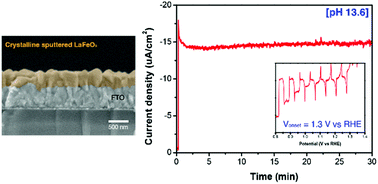Characteristics of crystalline sputtered LaFeO3 thin films as photoelectrochemical water splitting photocathodes†
Abstract
Stable photoelectrochemical (PEC) operation is a critical issue for the commercialization of PEC water-splitting systems. Unfortunately, most semiconductor photocathodes generating hydrogen in these systems are unstable in aqueous solutions. This is a huge limitation for the development of durable PEC water-splitting systems. Lanthanum iron oxide (LaFeO3) is a promising p-type semiconductor to overcome this drawback because of its stability in an aqueous solution and its proper energy level for reducing water. In this study, we fabricated a crystalline LaFeO3 thin film by radio frequency magnetron sputtering deposition and a post-annealing process in air for use as a PEC photocathode. Based on the morphological, compositional, optical and electronic characterizations, we found that it was ideal for a visible light-responsive PEC photocathode and tandem PEC water-splitting system with a small band gap absorber behind it. Furthermore, it showed stable PEC performance in a strong alkaline solution during PEC operation without any protection layers. Therefore, the crystalline sputtered LaFeO3 thin film suggested in this study would be feasible to apply as a PEC photocathode for durable, simple and low-cost PEC water splitting.



 Please wait while we load your content...
Please wait while we load your content...